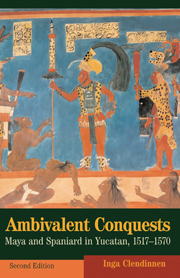Book contents
- Frontmatter
- Contents
- List of illustrations
- Preface to the second edition
- Preface to the first edition
- Acknowledgments
- Map I Yucatan in the conquest period
- Part I Spaniards
- 1 Explorers
- 2 Conquerors
- 3 Settlers
- 4 Missionaries
- 5 Conflict
- 6 Crisis
- 7 Attrition
- 8 Retrospections
- Epilogue: The hall of mirrors
- Part II Indians
- Epilogue: Confusion of tongues
- Appendix: A sampler of documents
- Glossary of Spanish and Maya terms
- Notes
- Select bibliography
- Index
1 - Explorers
Published online by Cambridge University Press: 05 October 2013
- Frontmatter
- Contents
- List of illustrations
- Preface to the second edition
- Preface to the first edition
- Acknowledgments
- Map I Yucatan in the conquest period
- Part I Spaniards
- 1 Explorers
- 2 Conquerors
- 3 Settlers
- 4 Missionaries
- 5 Conflict
- 6 Crisis
- 7 Attrition
- 8 Retrospections
- Epilogue: The hall of mirrors
- Part II Indians
- Epilogue: Confusion of tongues
- Appendix: A sampler of documents
- Glossary of Spanish and Maya terms
- Notes
- Select bibliography
- Index
Summary
We seldom or never find any nation hath endured so many misadventures and miseries as the Spaniards have done in their Indian discoveries. Yet persisting in their enterprises, with invincible constancy, they have annexed to their kingdom so many goodly provinces, as bury the remembrance of all dangers past … Many years have passed over some of their heads in the search of not so many leagues: Yea, more than one or two have spent their labour, their wealth, and their lives, in search of a golden kingdom, without getting further notice of it than what they had at their first setting forth …
Sir Walter Raleigh, The History of the World, 1614In 1502, on his fourth and final voyage, Christopher Columbus happened upon a great trading canoe just off the coast of Honduras. It was ‘long as a galley’, as Ferdinand, the Admiral's thirteen-year-old son recalled, and carved from one great tree trunk. Neither its twenty-five naked paddlers nor the richly clad men who appeared to be their masters offered any resistance as the Spaniards seized the craft, and they remained paralysed with fright as the bearded strangers rifled through the cargo. It was only when some cacao beans were allowed to spill from their containers in the course of the looting that they momentarily forgot their fear, scrambling to retrieve them ‘as if they were their eyes’.
Along with the precious cacao beans were copper axes and bells; razors and hatchets of a translucent yellow stone, probably Mexican obsidian; heavy wooden war clubs studded with flints; pottery; and garments of many-coloured woven cotton.
- Type
- Chapter
- Information
- Ambivalent ConquestsMaya and Spaniard in Yucatan, 1517–1570, pp. 3 - 19Publisher: Cambridge University PressPrint publication year: 2003

